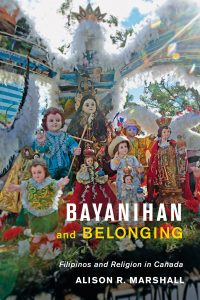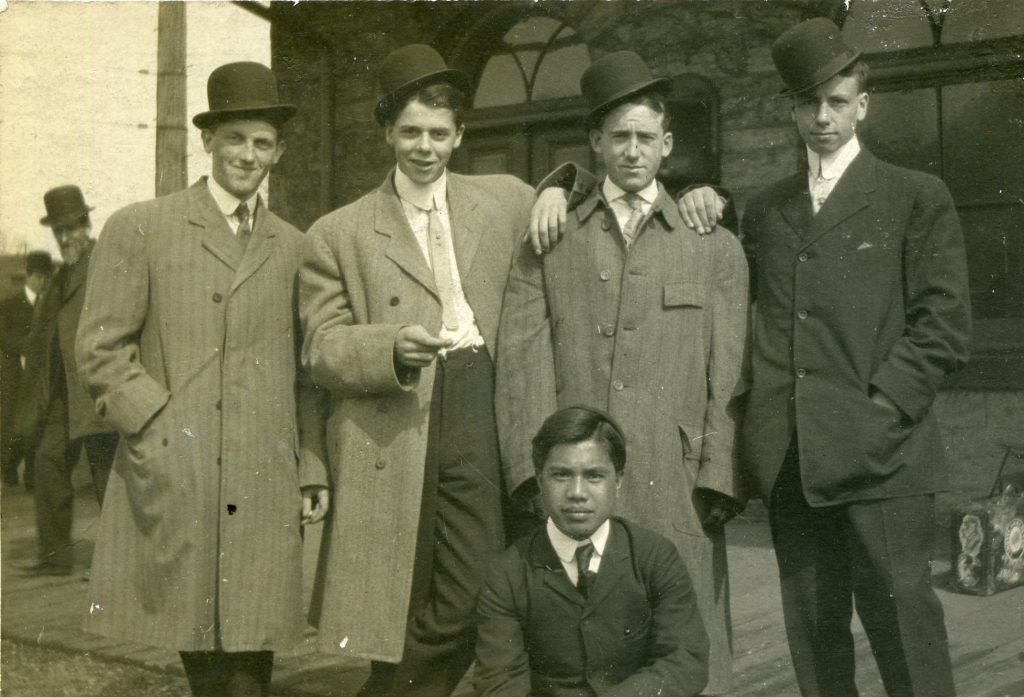A new book by Brandon University professor Dr. Alison Marshall is the first of its kind: “Bayanihan and Belonging” (University of Toronto Press, 2018) explores the experience of Filipino people in Canada, paying special attention to the importance of religion and belief as well as migration.
As a result of this publication, Dr. Marshall has been in demand as a speaker on the topic, with a well-attended and well-received talk on April 5 at Simon Fraser University. She is planning a Manitoba book launch for May 8 at McNally Robinson in Winnipeg.

“Filipinos make up one of the largest immigrant groups in Canada, and the majority continue to retain their Roman Catholic faith long after migrating,” Dr. Marshall says. “Drawing on archival and ethnographic research in Canada and the Philippines from 1880 to 2017, my book aims to understand the role of religion within present-day Filipino Canadian communities.”
Drawing on extensive research among the Filipino community in Canada, Dr. Marshall’s new book details how many Filipino people who migrated to Canada continue to define themselves religiously.
“Religious belief is often manifested through public and private devotion and practices and through affiliations to certain churches, deities, saints, groups, and festivals,” Dr. Marshall says. “I also pay particular attention to what we call the religious underside — the beliefs and practices that are often hidden. These might be a special coin conferring blessings and protection (an “anting-anting”) that is buried deep in a pocket.”
At other times, she explains, these hidden religious rituals also include private devotional or healing practices, including songs, prayers to religious and non-religious figures such as Santo Niño and Dr. José Rizal, pilgrimages, and actual embraces of a saint’s image for intercession.
“In Canada, Santo Niño devotion remains strong, both at church and beyond it,” Dr. Marshall says. “Along with Catholicism, this has provided Filipinos with a nationalist spiritual identity that has enabled them to live apart from kin.”
“Bayanihan and Belonging” puts a focus on Winnipeg, which is home to Canada’s oldest and largest Filipino-Canadian community, and showcases current church-based and domestic religious routines of migrant Filipinos. From St. Edward the Confessor Church, the principal site of worship for Filipino Catholics in Manitoba, to home chapels, and healing traditions, Marshall explores the day-to-day celebrations of bayanihan, or communal spirit. Drawing on experiences from Manitoba’s Filipino population, the book reveals that religious practice fulfills not only a need for spiritual guidance but also for community.
The book quotes Mike Pagtakhan, a Winnipeg City Councillor and nephew of Dr. Rey Pagtakhan, a former MP who was the first elected Canadian Filipino and who is also featured in the book.
Mike explains that so many Filipinos came to Winnipeg because they felt like they belonged, or because of Bayanihan.
“Winnipeg was the place to be, despite the fact that it’s cold. I think that there were lots of jobs for people, at the same time housing was affordable, and the whole notion of the community being close got spread back home,” he said. “And so when people heard that, my theory (is) that they just said, ‘Well, let’s go to Winnipeg. It’s great ’cause it feels like the Philippines,’ even though you’re not in the Philippines. Despite the fact that it’s cold, despite the fact that it’s a different culture, it just feels like you’re back in the Philippines.”
With a large Filipino-Manitoban population outside of Winnipeg as well, Dr. Marshall wrote an entire chapter on Brandon.
“I talk about a former BU professor and librarian who are both Filipino, as well as the Filipino experience in Neepawa and the rest of Manitoba,” Dr. Marshall said. “Communities such as Steinbach, Notre Dame de Lourdes, Morden, Carmen, Dauphin, Clear Lake, Carberry and Selkirk are all mentioned in my book.”
Emphasizing local connections with research that is important both locally and worldwide demonstrates the impact that Brandon University faculty make every day, says BU Dean of Arts Dr. Demetres P. Tryphonopoulos.

“The movement of people to new places, carrying with them their cultures and religions, is one of the great stories of human history, and this movement is becoming increasingly common as transportation technology eases global migration,” Dr. Tryphonopoulos said. “As Dr. Marshall has previously done with her research into the early Chinese-Canadian community, her current work is an important investigation into the Filipino-Canadian experience that brings a particular focus on Manitoba, on Westman and on Brandon.
“It is thanks to Dr. Marshall’s dedication, insight and sensitivity that these local immigration experiences are being placed alongside others on the national stage, where they are given the attention and profile they deserve.”
Early reactions to the book are glowing and sales have been very strong. It is available online at UTorontoPress.com.
“In this work, Alison Marshall once again renders visible a portion of Canada’s multicultural and religiously diverse mosaic that generally receives little attention in the literature or even in public discussion. Whereas in her previous work that group was the ethnically Chinese population of the pre-1970s era, here she shows the diversity and complexity of the histories and biographies of those who have come to Canada from the Philippines,” said Peter Beyer, from the Department of Classics and Religious Studies at the University of Ottawa. “In telling their stories and letting them tell their stories, with emphasis on what has been important to them in their settlement in Canada, Marshall goes beyond vague conceptions and stereotypes to recover and profile what may be lost or invisible. The book makes a genuine contribution and should be recommended to anyone who wants to see what diversity in our country actually looks like in person and on the ground.”
Now, Dr. Marshall says she is hoping to re-connect with some of the people who were featured in the book so she can share the final work with them.
“Some people have moved or changed email addresses and telephone numbers so I have not been able to let them know,” she says. “I am eager to share the book with them, and hope they reach out and contact me so that we can arrange a way to pick up a free copy.”
Dr. Marshall can be contacted at 204.727.7322 or MarshallA@BrandonU.CA.
From “Bayanihan and Belonging”
About Hilary Clapp

Hilary Pit-a-pit Clapp was an Igorot youth, and his conversion to Christianity marked a turning point in Episcopalian missionary work and also in Canadian history. It is said that prior to Pit-a-pit’s conversion, no Igorot child had been attracted to Christianity. Hilary Clapp was brought to Canada in 1907, a time when many North Americans had come to know the Philippines through the large numbers of Igorots and other Filipinos being paraded as head hunters and dog eaters at international fairs. Pit-a-pit, now known as Hilary Pit-a-pit Clapp, was under the guardianship of Reverend Walter Clapp. Hilary came to Canada in 1907 and was the first Filipino to attend Trinity College School in Port Hope, Ontario. Founded in 1865, the institution was an elite boarding academy patterned after American schools. Almost all the students were “white” Anglicans of European descent. When it was deemed that he was ready to return to the Philippines and Christianize others, Clapp returned to the Philippines in 1910.
About BIBAK

BIBAK is a group that performed Ifugao and Bontoc festival dances at Filipino events in Winnipeg.
BIBAK had started in Baguio City (the largest city in the mountainous region) in the 1950s. The acronym BIBAK is a legacy of the American colonial period in the Philippines. Americans introduced the term to define the five major tribes from the Cordilleras, a mountain range in the northern Philippines: Benguet, Ifugao, Bontoc, Apayao, and Kalinga.
There are now also BIBAK groups in Toronto, Vancouver, Montreal, Calgary, Edmonton, and throughout the world. One in Regina is being formed. Each year, the BIBAK Association of Manitoba hosts a Cañao (an Igorot festival), at which tribal cultures are celebrated. In the nineteenth and early twentieth centuries, the Cañao provided the inspiration for popular and exploited performances by Igorots at American exhibitions and fairs, as I discussed earlier in the book. Cañaos today are commonly held in Baguio City to celebrate the culture of the region, and throughout the diaspora.
Contact
- Brandon University
- communications@brandonu.ca
To receive any BU publication in an alternate format please contact Communications@BrandonU.ca
About BU
Success is built at Brandon University. Our growing, progressive campus welcomes a diverse and inclusive community that combines proud tradition with shared ambition. Through our excellence in teaching, research, and scholarship, we educate students to make a meaningful difference as engaged citizens and leaders. Join us at BrandonU.ca.